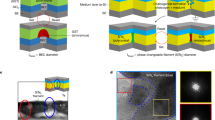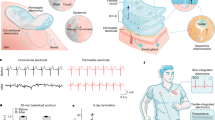Abstract
Bioelectronic devices must be fast and sensitive to interact with the rapid, low-amplitude signals generated by neural tissue. They should also be biocompatible and soft, and should exhibit long-term stability in physiologic environments. Here, we develop an enhancement-mode, internal ion-gated organic electrochemical transistor (e-IGT) based on a reversible redox reaction and hydrated ion reservoirs within the conducting polymer channel, which enable long-term stable operation and shortened ion transit time. E-IGT transient responses depend on hole rather than ion mobility, and combine with high transconductance to result in a gain–bandwidth product that is several orders of magnitude above that of other ion-based transistors. We used these transistors to acquire a wide range of electrophysiological signals, including in vivo recording of neural action potentials, and to create soft, biocompatible, long-term implantable neural processing units for the real-time detection of epileptic discharges. E-IGTs offer a safe, reliable and high-performance building block for chronically implanted bioelectronics, with a spatiotemporal resolution at the scale of individual neurons.
This is a preview of subscription content, access via your institution
Access options
Access Nature and 54 other Nature Portfolio journals
Get Nature+, our best-value online-access subscription
$29.99 / 30 days
cancel any time
Subscribe to this journal
Receive 12 print issues and online access
$259.00 per year
only $21.58 per issue
Buy this article
- Purchase on Springer Link
- Instant access to full article PDF
Prices may be subject to local taxes which are calculated during checkout






Similar content being viewed by others
Data availability
All data needed to evaluate the conclusions in the paper are present in the paper and/or the Supplementary Information. All source files and experimental data are freely and publicly available at www.dion.ee.columbia.edu. Additional data related to this paper may be requested from the authors.
References
Chen, R., Canales, A. & Anikeeva, P. Neural recording and modulation technologies. Nat. Rev. Mater. 2, 1–16 (2017).
Jeong, J. W. et al. Soft materials in neuroengineering for hard problems in neuroscience. Neuron 86, 175–186 (2015).
Someya, T., Bao, Z. & Malliaras, G. G. The rise of plastic bioelectronics. Nature 540, 379–385 (2016).
Spyropoulos, G. D., Gelinas, J. N. & Khodagholy, D. Internal ion-gated organic electrochemical transistor: a building block for integrated bioelectronics. Sci. Adv. 5, eaau7378 (2019).
Fang, H. et al. Ultrathin, transferred layers of thermally grown silicon dioxide as biofluid barriers for biointegrated flexible electronic systems. Proc. Natl Acad. Sci. USA 113, 11682–11687 (2016).
Kim, D.-H. et al. Stretchable and foldable silicon integrated circuits. Nature 320, 507–511 (2008).
Cho, J. H. H. et al. High-capacitance ion gel gate dielectrics with faster polarization response times for organic thin film transistors. Adv. Mater. 20, 686–690 (2008).
Kim, S. H. et al. Electrolyte-gated transistors for organic and printed electronics. Adv. Mater. 25, 1822–1846 (2013).
Panzer, M. J. & Frisbie, C. D. Polymer electrolyte-gated organic field-effect transistors: low-voltage, high-current switches for organic electronics and testbeds for probing electrical transport at high charge carrier density. J. Am. Chem. Soc. 129, 6599–6607 (2007).
Zare Bidoky, F. et al. Sub-3 V ZnO electrolyte-gated transistors and circuits with screen-printed and photo-crosslinked ion gel gate dielectrics: new routes to improved performance. Adv. Funct. Mater. https://doi.org/10.1002/adfm.201902028 (2019).
Song, E. et al. Flexible electronic/optoelectronic microsystems with scalable designs for chronic biointegration. Proc. Natl Acad. Sci. USA 116, 15398–15406 (2019).
Rivnay, J. et al. Organic electrochemical transistors. Nat. Rev. Mater. 3, 17086 (2018).
Giovannitti, A. et al. Controlling the mode of operation of organic transistors through side-chain engineering. Proc. Natl Acad. Sci. USA 113, 12017–12022 (2016).
Nielsen, C. B. et al. Molecular design of semiconducting polymers for high-performance organic electrochemical transistors. J. Am. Chem. Soc. 138, 10252–10259 (2016).
Schmode, P. et al. High-performance organic electrochemical transistors based on conjugated polyelectrolyte copolymers. Chem. Mater. 31, 5286–5295 (2019).
Bernards, D. A. & Malliaras, G. G. Steady-state and transient behavior of organic electrochemical transistors. Adv. Funct. Mater. 17, 3538–3544 (2007).
Stavrinidou, E. et al. Direct measurement of ion mobility in a conducting polymer. Adv. Mater. 25, 4488–4493 (2013).
Khodagholy, D. et al. High speed and high density organic electrochemical transistor arrays. Appl. Phys. Lett. 99, 163304 (2011).
Crispin, X. et al. The origin of the high conductivity of poly(3,4-ethylenedioxythiophene)−poly(styrenesulfonate) (PEDOT:PSS) plastic electrodes. Chem. Mater. 18, 4354–4360 (2006).
Spyropoulos, G. D. et al. Organic and perovskite solar modules innovated by adhesive top electrode and depth-resolved laser patterning. Energy Environ. Sci. 9, 2302–2313 (2016).
Zhou, Y. et al. A universal method to produce low–work function electrodes for organic electronics. Org. Electron. 873, 327–332 (2012).
Lin, Z. et al. A work-function tunable polyelectrolyte complex (PEI:PSS) as a cathode interfacial layer for inverted organic solar cells. J. Mater. Chem. A 2, 7788–7794 (2014).
Xuan, Y., Sandberg, M., Berggren, M. & Crispin, X. An all-polymer-air PEDOT battery. Org. Electron. Phys. Mater. Appl. 13, 632–637 (2012).
Van de Burgt, Y. et al. A non-volatile organic electrochemical device as a low-voltage artificial synapse for neuromorphic computing. Nat. Mater. 16, 414–418 (2017).
Zozoulenko, I. et al. Polarons, bipolarons, and absorption spectroscopy of PEDOT. ACS Appl. Polym. Mater. 1, 83–94 (2019).
Ravi Kumar, M. N. V. A review of chitin and chitosan applications. React. Funct. Polym. 46, 1–27 (2000).
Jiang, H. L. et al. Chitosan-graft-polyethylenimine as a gene carrier. J. Control. Release 117, 273–280 (2007).
Khodagholy, D. et al. In vivo recordings of brain activity using organic transistors. Nat. Commun. 4, 1575 (2013).
Khodagholy, D. et al. High transconductance organic electrochemical transistors. Nat. Commun. 4, 2133 (2013).
Rivnay, J. et al. High-performance transistors for bioelectronics through tuning of channel thickness. Sci. Adv. 1 e1400251 (2015).
Inal, S., Malliaras, G. G. & Rivnay, J. Benchmarking organic mixed conductors for transistors. Nat. Commun. 8, 1767 (2017).
Khodagholy, D. et al. NeuroGrid: recording action potentials from the surface of the brain. Nat. Neurosci. 18, 310–315 (2015).
Krook-Magnuson, E., Gelinas, J. N., Soltesz, I. & Buzsáki, G. Neuroelectronics and biooptics: closed-loop technologies in neurological disorders. JAMA Neurol. 72, 823–829 (2015).
Choi, H. H., Cho, K., Frisbie, C. D., Sirringhaus, H. & Podzorov, V. Critical assessment of charge mobility extraction in FETs. Nat. Mater. 17, 2–7 (2018).
Rivnay, J. et al. Structural control of mixed ionic and electronic transport in conducting polymers. Nat. Commun. 7, 11287 (2016).
Podzorov, V. Organic single crystals: addressing the fundamentals of organic electronics. MRS Bull. 38, 15–24 (2013).
Crone, B. et al. Large-scale complementary integrated circuits based on organic transistors. Nature 403, 521 (2000).
Kim, Y. et al. A bioinspired flexible organic artificial afferent nerve. Science 360, 998–1003 (2018).
Sessolo, M. et al. Easy-to-fabricate conducting polymer microelectrode arrays. Adv. Mater. 25, 2135–2139 (2013).
Khodagholy, D., Gelinas, J. N. & Buzsáki, G. Learning-enhanced coupling between ripple oscillations in association cortices and hippocampus. Science 372, 369–372 (2017).
Peyrache, A., Battaglia, F. P. & Destexhe, A. Inhibition recruitment in prefrontal cortex during sleep spindles and gating of hippocampal inputs. Proc. Natl Acad. Sci. USA 108, 17207–17212 (2011).
Khan, F., Tare, R. S., Oreffo, R. O. C. & Bradley, M. Versatile biocompatible polymer hydrogels: scaffolds for cell growth. Angew. Chem. Int. Ed. 48, 978–982 (2009).
Buzsaki, G. Hippocampal sharp wave-ripple: a cognitive biomarker for episodic memory and planning. Hippocampus 25, 1073–1188 (2015).
Morrell, M. J. Responsive cortical stimulation for the treatment of medically intractable partial epilepsy. Neurology 77, 1295–1304 (2011).
González Otárula, K. A., Mikhaeil-Demo, Y., Bachman, E. M., Balaguera, P. & Schuele, S. Automated seizure detection accuracy for ambulatory EEG recordings. Neurology 92, e1540–e1546 (2019).
Buzsáki, G., Anastassiou, C. A. & Koch, C. The origin of extracellular fields and currents—EEG, ECoG, LFP and spikes. Nat. Rev. Neurosci. 13, 407–420 (2012).
Gelinas, J. N., Khodagholy, D., Thesen, T., Devinsky, O. & Buzsáki, G. Interictal epileptiform discharges induce hippocampal–cortical coupling in temporal lobe epilepsy. Nat. Med. 22, 641–648 (2016).
Inal, S. et al. A high transconductance accumulation mode electrochemical transistor. Adv. Mater. 26, 7450–7455 (2014).
Viventi, J. et al. Flexible, foldable, actively multiplexed, high-density electrode array for mapping brain activity in vivo. Nat. Neurosci. 14, 1599–1605 (2011).
Zeglio, E. et al. Conjugated polyelectrolyte blends for electrochromic and electrochemical transistor devices. Chem. Mater. 27, 6385–6393 (2015).
Acknowledgements
This work was supported by Columbia University, School of Engineering and Applied Science as well as Columbia University Medical Center, Department of Neurology and Institute for Genomic Medicine. The device fabrication was performed at Columbia Nano-Initiative (CNI) and at Cornell NanoScale Facility (CNF), a member of the National Nanotechnology Coordinated Infrastructure (NNCI), which is supported by the National Science Foundation (Grant ECCS-1542081). G.D.S. is supported through the Human Frontiers Postdoctoral Fellowship Program. This work was supported by an NIH grant (1U01NS108923-01), NSF CAREER award (1944415), CURE Taking Flight Award, Columbia School of Engineering. We thank M. Gonzalez, J. Yu, J. Vichiconti, Y. Borisenkov, P. Chow, C. Belfer, N. Ariel-Sternberg (CNI) and all Khodagholy and Gelinas laboratory members for their support.
Author information
Authors and Affiliations
Contributions
D.K., J.N.G. and C.C. conceived the project. C.C., D.K., G.D.S. and P.J. designed, developed, fabricated and characterized the materials and devices. C.C. and G.D.S. fabricated the neural probes for the rodent and human recordings. C.C. and G.D.S. performed the ECG and EMG recordings. D.K., C.C., J.J.F. and J.N.G. performed the electrophysiology in vivo rodent experiments and analysis. All authors contributed to writing the paper.
Corresponding authors
Ethics declarations
Competing interests
The authors declare no competing interests.
Additional information
Publisher’s note Springer Nature remains neutral with regard to jurisdictional claims in published maps and institutional affiliations.
Supplementary information
Supplementary Information
Supplementary Figs. 1–18, Tables 1–2
Rights and permissions
About this article
Cite this article
Cea, C., Spyropoulos, G.D., Jastrzebska-Perfect, P. et al. Enhancement-mode ion-based transistor as a comprehensive interface and real-time processing unit for in vivo electrophysiology. Nat. Mater. 19, 679–686 (2020). https://doi.org/10.1038/s41563-020-0638-3
Received:
Accepted:
Published:
Issue Date:
DOI: https://doi.org/10.1038/s41563-020-0638-3
This article is cited by
-
Flexible switch matrix addressable electrode arrays with organic electrochemical transistor and pn diode technology
Nature Communications (2024)
-
3D spatiotemporally scalable in vivo neural probes based on fluorinated elastomers
Nature Nanotechnology (2024)
-
Monolithically integrated high-density vertical organic electrochemical transistor arrays and complementary circuits
Nature Electronics (2024)
-
Development of environmental friendly Mo-doped MnO2 via hydrothermal route for supercapacitor as pollution-free source of energy
Applied Physics A (2024)
-
Metal oxide ion gated transistors based sensors
Science China Technological Sciences (2024)



